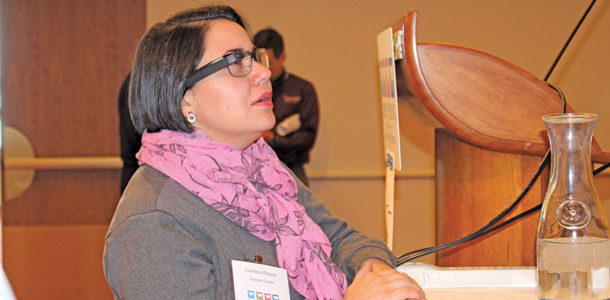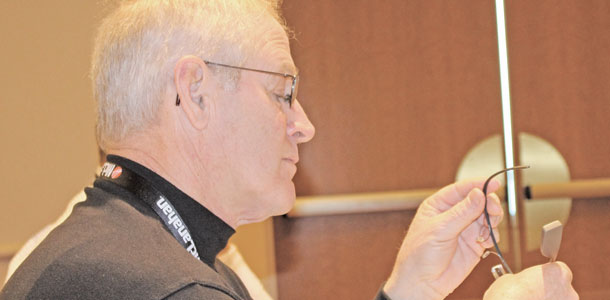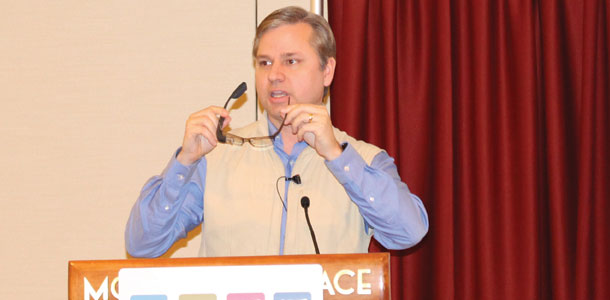All that glitters is not gold. Especially for Google Glass. If you have been to an industry meeting or conference this winter, wearable technology is being touted as the “next big thing” in agriculture. From smart watches to Bluetooth technology to Google’s smart glasses (Google Glass), it’s all hands-free communication.
The ability to troubleshoot problems with machinery, diagnose illness in cattle without fumbling for your phone and real-time crop scouting are just a few of the applications in which wearable devices could change the way farmers do business.
Despite all the attention “wearables” are getting, the hype surrounding Google Glass might be just that.
In mid-January, Google announced via the Google Glass social media pages that it would be discontinuing the Google Explorers program. This public, beta testing group includes more than 8,000 Americans who applied via Twitter for the chance to purchase the Google Glass prototype (for the hefty investment of $1,500) to aid in the development of the product that would launch to the mass market. But after more than two years in beta testing, Google Glass still didn’t have a launch date.
In its statement, Google thanked the Google Explorers. “Glass was in its infancy, and you took those very first steps and taught us how to walk. Well, we still have some work to do, but now we’re ready to put on our big kid shoes and learn how to run.”
Bruce Rasa, CEO and founder of TekWear LLC in Buford, Georgia, has been making the rounds presenting to agriculture audiences about the benefits of wearable technology, including Google Glass. Rasa spoke to a packed house at the Dairy Strong Conference, Jan. 13-15 in Madison, Wisconsin. Google announced it was going back to the drawing board with Google Glass on Jan. 15. Talk about timing.
Not another ‘techy toy’
“What may look like a toy today, will become a tool tomorrow,” Rasa said. “Devices are getting smaller, but they are still computers.”
The term “wearable device,” “wearable technology” or simply “wearables” for short, applies to any hands-free device that is worn on the user’s body. Bluetooth devices worn on or in the ear have been around for several years and are a widely used tool when driving or engaging in activity that requires the use of both hands.
Smart watches are worn on the wrist and maintain a connection to the user’s cell phone via Bluetooth. It can receive notifications of calls, texts, social media updates and more. Some watches even allow you to conduct calls from the watch. Newer models work just like a cell phone all on their own.
Google Glass is one product in the smart glasses category. “It’s a smartphone on your face that connects to your phone using Bluetooth,” Rasa said. “It’s like looking through a rearview mirror, but you can see through it.”
Google Glass can be used with or without access to the Internet (although access to cellular data is what creates the real-time features). It has a 5-megapixel camera and video capabilities similar in quality to a HD TV at home. Google Glass comes in a variety of rim choices, prescription lenses and in sunglasses.
Agriculture impact
When Google unveiled the Google Explorers program in 2013, there were 110,000 applicants. Of those, only five had a connection to agriculture. Rasa was selected as one of the 8,000 Google Explorers and planned to test Google Glass in agriculture settings.
So just how could wearable technology impact agriculture? Google Glass has been tested as a precision agriculture tool using GPS coordinates.
Google Glass is being tested to diagnose machinery problems in real time. “Simply take a picture and send it to your rep without stopping the tractor or combine,” Rasa said.
The video and chat capabilities are also being tested to diagnose crop diseases and pests.
Researchers at the University of Wisconsin School of Veterinary Medicine were the first vet school to use Google Glass as a teaching tool when they recorded and live-streamed surgeries from the first-person perspective.
Looking into the future, smart glasses such as Google Glass could help dairy herd managers expedite herd health checks. Instead of spending hours in the pen taking notes only to re-enter data in the office, a tool like Google Glass could take notes in real time as long as it was compatible with popular programs like DairyComp 305 or other RFID readers.
Where’s the love?
From its inception, Google Glass had critics. Most still agree that wearables (as a whole) are the future of mobile communication – but can’t deal with the awkward look of the devices.
“You were always asking me to choose,” wrote Lance Ulanoff, editor-in-chief at Mashable, a leading source for news on digital innovation in a November opinion post. “A wearable should be something I can wear all the time without compromise or feeling ridiculous.”
As Rasa said, it’s a computer on your face, and most people don’t want to walk around with a gadget on their head. Even after years on the market, it’s still weird to see someone walking around wearing a Bluetooth headset talking to themselves (or so it seems). Google Glass in its current state is just not fashionable.
The next big drawback is the price. Google Explorers paid $1,500 to test the Google Glass prototype. “The guts cost $150. Imagine how popular they would be at the $299 price point,” Rasa said.
Prior to the Google’s announcement in January, it was thought that Google Glass would be released this summer in the $700 to $800 price range. It was all speculation because there will be no launch date now. Yet even at $700, Google Glass may have been too expensive for most farmers.
The third major concern is security and data privacy, but Rasa is quick to point out that wearables don’t pose any risk beyond a cell phone. “There is no difference between using Glass and using your phone,” he said. “The privacy is no different.”
OK, Glass. Now what?
Just because Google Glass is on hold doesn’t mean wearables are a failure. They just need some refining.
During his presentation (before Google announced that it was pulling the plug on the Explorer program), Rasa said that Google was in talks with several eyewear brands, including Oakley and Ray Ban, to perfect the design of the glasses – hopefully into something … normal-looking.
Billions of dollars have been invested into the wearable industry, and it’s unlikely that Google Glass is gone forever. “We’re continuing to build for the future, and you’ll start to see future versions of Glass when they’re ready. (For now, no peeking.),” the company assured its fans via Facebook.
The agriculture community is innovative and open to change when it makes sense for the farm. If there is an application of wearable technology that will advance agriculture, farmers will use it.
“My grandpa bought a tractor but still kept his horses around,” Rasa said. “There were times when oats were cheaper than gas. We are not asking farmers to abandon what you are doing, but [wearable technology] is something that is available.” PD
Maria F. McGinnis is a freelance writer based in Sun Prairie, Wisconsin.
PHOTOS
TOP: Carolina Pinzon-Sanchez, dairy field services representative with Grande Cheese, tries Google Glass on for size during a wearable technology presentation at the Dairy Strong Conference in Madison, Wisconsin.
MIDDLE: During a session at the Dairy Strong Conference, wearable devices including the Google Glass prototype were passed around the room for everyone to try.
BOTTOM: Bruce Rasa, CEO and founder of TekWear, LLC in Buford, Georgia, introduced several wearable technology platforms to attendees of the Dairy Strong Conference in Madison, Wisconsin. Photos courtesy of Maria F. McGinnis.






